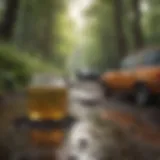Top Fishing Spots in Washington State: A Comprehensive Guide
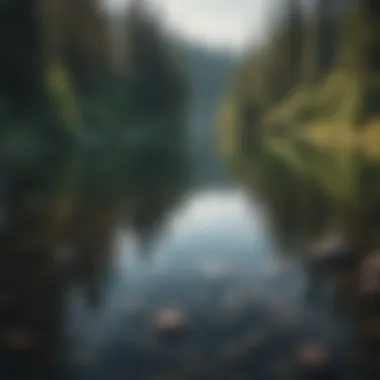

Intro
Washington State boasts a stunning array of fishing venues, making it a prime spot for enthusiasts and the casual angler alike. With countless lakes, streams, and rivers, it’s easy to find a perfect setting to cast a line. But fishing in this region isn't simply about recreation; it’s intertwined with the culture, economy, and ecological balance of local communities.
The state's natural resources provide not just an avenue for leisure, but also a home for various fish species, some of which are iconic to the Pacific Northwest. From the shimmering bodies of water in the Cascade Mountains to the open shores along the Pacific coast, each locale offers its own flavor and experience.
As one dives into this topic, it’s essential to recognize fishing in Washington State as a practice laden with history. Indigenous tribes have fished these waters for generations, relying on them for both sustenance and cultural practices. This rich tapestry of fishing is not just an outdoor activity, but a vital thread in the fabric of the region's identity.
The focus on fishing locations will reveal the specific environments where fish thrive and the conditions necessary for sustainable practices. Understanding these regions paves the way for not only a successful fishing trip but also a greater appreciation for the natural world and the conservation efforts vital for its preservation.
Overview of Fishing in Washington State
Fishing in Washington State represents a significant facet of both recreation and conservation, attracting various enthusiasts from all walks of life. From the jagged mountains to the serene coastlines, the state offers a diverse array of fishing opportunities that cater to all skill levels. Engaging in this outdoor activity is not just about the catch but also about connecting with nature and understanding the delicate balance within local ecosystems.
Historical Context
Fishing in Washington has roots that reach deep into the history of Native American tribes, who have relied on its bountiful waters for sustenance for millennia. Rich in salmon runs, rivers like the Columbia and the Snake became lifelines for many indigenous communities. The state's economy has long depended on fishing, with developments in commercial fisheries and recreational fishing evolving over the decades.
As industrialization crept in during the 19th century, conflicts arose between the needs of the growing population and those of the fish. Consequently, historical practices led to overfishing in some areas, prompting the call for regulations to sustain fish populations and habitats. This context shapes the way fishing is perceived and practiced today, highlighting the thread of stewardship that runs through generations.
Fishing Regulations and Licenses
In Washington State, fishing is not just a leisurely pursuit; it's accompanied by stringent regulations intended to protect fish populations and their habitats. Before heading out, anglers must obtain the appropriate licenses, unless exemptions apply. Licenses can typically be purchased online or at numerous retailers across the state.
Key regulations to consider include:
– Specific seasons for different species,
– Daily catch limits, and
– Designated fishing areas that may have particular restrictions.
The Washington Department of Fish and Wildlife (WDFW) provides an up-to-date resource for laws that anglers must comply with, emphasizing the importance of responsible fishing practices. Understanding these regulations helps ensure that waters remain vibrant for years to come.
Impact of Fishing on Local Ecosystems
Fishing indisputably has a profound impact on local ecosystems. When managed sustainably, it can bolster fish populations and promote habitat restoration. The interactions between fish and their environment ebb and flow with seasonal changes, affecting not only the fish themselves but also the broader ecological community.
With that said, unsustainable fishing practices can lead to detrimental consequences. Overfishing can disrupt the balance, leading to diminished fish stocks and altering food chains. Special attention must be paid to habitat loss due to pollution and overdevelopment.
Anglers today are increasingly aware of their responsibilities, often participating in conservation efforts that focus on:
- Protecting spawning habitats,
- Participating in catch-and-release programs,
- Advocating for environmentally friendly practices.
In summary, fishing in Washington carries an intricate tapestry of historical relevance, regulatory frameworks, and ecological considerations. By understanding and respecting these aspects, anglers can enjoy a fulfilling experience while also nurturing the waters they cherish.
Top Freshwater Fishing Spots
When it comes to fishing in Washington State, freshwater locations offer a diverse playground for anglers. The appeal of these spots lies not only in the variety of fish species available but also in the environments they provide for fishing enthusiasts. Each lake or river has its unique character and community, making it an essential subject for both novice and seasoned fishers. These fishing areas have their own stories and ecological dynamics, which greatly enhance the overall fishing experience.
Lake Washington
Lake Washington is a crown jewel amidst the state's fishing locations. Its vastness and rich ecosystem attract many fishing aficionados each year.
Species Found
Within Lake Washington, you can expect to encounter a plethora of species. One of the most notable is the rainbow trout, prized for its fight and flavor. Additionally, largemouth bass are plentiful, drawing in anglers looking for a challenge. The lake also harbors perch and catfish, providing even more options for those casting their lines. Each species has its unique thrill, with rainbow trout being particularly sought after for its vibrant colors and acrobatic jumps. However, sometimes finding these fish can be a bit like searching for a needle in a haystack, especially for those not familiar with the water.
Best Times for Fishing
The timing of your fishing trip to Lake Washington can significantly affect your success. Early mornings and late evenings are often the golden hours when fish are most active, especially during warm months. As temperatures drop in autumn, the fishing tends to slow but can yield fantastic catches when conditions are right. The allure of fishing at dawn, when the mist rises off the water and the world seems quiet, is an experience in itself. However, it's crucial to be prepared for changing weather patterns, as conditions can turn on a dime.
Access Points
Several designated access points around Lake Washington make it easy for anglers to get started. Public parks such as Genesee Park and Magnolia Park provide recreational access to the water's edge. Many of these spots feature fishing piers, which allow for a more comfortable fishing experience. One unique aspect is that some locations are equipped with amenities like boat launches and restrooms, which can make for a more pleasant outing. Nevertheless, it’s wise to gauge the accessibility of each point, especially during busy summer weekends, as they can quickly fill up.
Spokane River
Known for its breathtaking views and robust fish population, the Spokane River is another freshwater haven worth exploring.
Catch Techniques
Fishing in the Spokane River often requires specific catch techniques due to the river's current and structure. Techniques such as fly-fishing or spinning with lures can lead to successful catches, especially for trout and steelhead. Much like playing chess, knowing when and how to adapt your technique can mean the difference between a day of casting and an actual haul. Utilizing the right tackle and bait is vital to navigating the diverse depths and flows of the river.
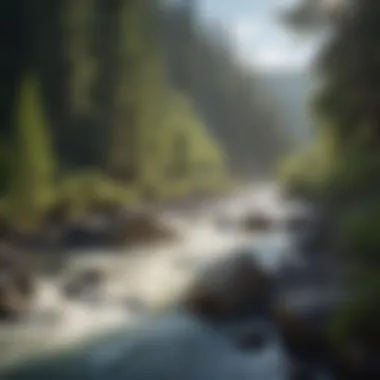

Seasonal Highlights
The Spokane River offers seasonal fishing highlights that can draw passionate anglers. In the spring, you might experience a spectacular run of steelhead, providing an exhilarating challenge. Fall, on the other hand, is marked by an uptick in trout activity, allowing fishers to enjoy a fruitful outing. Each season brings its charm, and savvy anglers will often plan their fishing trips around these migratory patterns.
Safety Considerations
Considering safety when fishing the Spokane River cannot be overstated. The currents can be treacherous, especially after heavy rains or during early spring runoff. It's wise to wear a personal flotation device if you're fishing by boat or near swift water. Furthermore, being mindful of weather conditions, slippery rocks, and potential wildlife encounters helps create a safer fishing experience overall. Protecting oneself ensures that the focus can remain on the enjoyable pursuit of fishing rather than on unforeseen hazards.
Columbia River
The Columbia River, with its majestic flow and diverse ecosystem, is another prime fishing destination in Washington State.
Notable Fishing Areas
Numerous notable fishing areas along the Columbia River provide varied experiences for anglers. The Hanford Reach, for instance, is recognized for its wild salmon runs, making it an essential spot for those targeting these prized fish. Other lesser-known areas, like the Tri-Cities, also offer excellent opportunities, often with fewer crowds. Each area brings different challenges and joys, with some being great for shore casting while others are best reached by boat.
Fish Migration Patterns
The fish migration patterns in the Columbia are fascinating and incredibly important for local ecosystems. Understanding when and where fish veer toward shallower waters to spawn can open doors for greater catches. Salmon, especially, become relatively easier to target during their migration. Along with that, anglers might catch glimpses of changing wildlife, making this not just a fishing trip but also an adventure in natural observation.
Environmental Factors
Environmental concerns play a significant role in the Columbia River's fishing landscape. Changes in water temperature, pollution levels, and habitat loss can impact fish populations and, by extension, fishing success. Keeping an eye on these factors often means staying informed and adjusting fishing practices accordingly. The health of this river reflects wider ecological trends, making it essential for anglers to engage in sustainable fishing practices as part of understanding their local environment.
Coastal Fishing Locations
Coastal fishing locations in Washington State present a unique blend of ecological beauty and diverse aquatic life. The coastal waters are home to various species, making them favorable spots for both recreational and commercial fishing. Engaging with these locations not only enriches the fishing experience but also raises awareness about the delicate balance of marine ecosystems. The Olympic Coast and Puget Sound are two standout areas within this realm, with each offering distinct opportunities and challenges for fishing enthusiasts.
Olympic Coast
Types of Fish Available
Exploring the types of fish available along the Olympic Coast unveils a bounty that speaks to the richness of its marine habitat. Species such as salmon, halibut, and rockfish populate these waters. Salmon, for instance, are not only sought after for their taste but also for the thrill they bring to anglers. The presence of diverse fish populations means there's something for everyone, whether you're a novice or seasoned fisherman.
- Key characteristics: The abundance of salmon and other species strongly appeal to anglers for sport fishing.
- Unique features: The unique tides and currents shaped by the coastal environment influence fish behavior, making for exciting fishing dynamics.
- Advantages: The variety in fish species means extended fishing seasons and varied techniques can be employed, enhancing the overall fishing prospect.
Regulations Specific to the Coast
Understanding the regulations specific to the Olympic Coast is crucial for responsible fishing practices. These guidelines are designed to protect fish populations, ensuring sustainability for future generations. Anglers are often required to adhere to specific catch limits and seasons.
- Key characteristics: These regulations help create a balanced ecosystem in coastal waters, supporting both fish populations and the communities reliant on fishing.
- Unique features: Certain areas may be designated as protected zones, limiting fishing to recreational purposes only.
- Disadvantages: Compliance can sometimes be restrictive for local fishermen, impacting their ability to engage freely in fishing.
Best Access Trails
Finding the best access trails to the Olympic Coast is essential for maximizing the fishing trip experience. The trails lead to some hidden spots that are off the radar, offering peace and solitude for those who wish to escape the busier locations. These trails facilitate easy entry to prime fishing spots.
- Key characteristics: Many access routes are well-marked and maintained, making it easy for anglers of all skill levels to reach the water with minimal hassle.
- Unique features: Some trails wind through stunning natural landscapes, adding to the enjoyment of the trip both in transit and when catching fish.
- Advantages: Good access points often correlate with high fish activity, translating to more successful outings.
Puget Sound
Target Species
In Puget Sound, the variety of target species is impressive and appealing to dedicated anglers. Common finds include steelhead, chinook salmon, and various shellfish. The diversity in the target species is largely due to the varying environments within the sound, like sheltered bays and open waters.
- Key characteristics: The sound allows for different fishing strategies catering to the habits and habitats of various species.
- Unique feature: The seasonal runs of salmon provide some of the most exciting fishing opportunities, creating a fishing culture that celebrates these migrations.
- Advantages: Fishermen can enjoy year-round fishing for different species as the seasons change.
Weather Impacts on Fishing
Weather in Puget Sound can greatly impact fishing conditions, thus knowledge on this is essential. Variability in wind, rain, and temperature can determine the best times to fish. Anglers must be prepared to adapt to changing conditions.
- Key characteristics: Understanding local weather patterns helps anticipate fish movements and optimize fishing success.
- Unique feature: Certain weather conditions can actually trigger feeding frenzies, offering opportunities for exceptional catches.
- Disadvantages: Unpredictable storms can hinder fishing trips, emphasizing the need for caution and awareness.
Conservation Efforts
Conservation efforts in the Puget Sound area aim to protect its unique marine environment and fish populations. Many organizations are actively working to restore habitats and promote sustainable fishing practices.
- Key characteristics: Initiatives focus on habitat restoration, water quality enhancements, and community engagement.
- Unique features: Programs often involve local fishermen in the conservation dialogue, promoting sustainable practices.
- Advantages: These efforts contribute positively to long-term fishing prospects and biodiversity preservation, ensuring future generations can enjoy these rich fishing grounds.
Fishing Tactics and Equipment Considerations
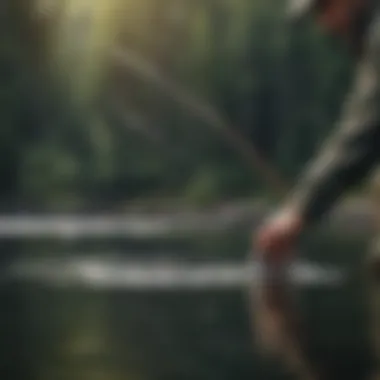

Fishing is not just a hobby; it’s an art that combines skill, patience, and knowledge of the environment. Understanding various fishing tactics and selecting the appropriate equipment plays a crucial role in achieving a successful day on the water. For anglers, especially in Washington State, knowing the right techniques and gear can enhance both yield and enjoyment. The following paragraphs unpack relevant gear choices and techniques that anglers should consider to optimize their experience.
Choosing the Right Gear
When it comes to fishing, having the right gear is half the battle won. The market is overflowing with options, making it easy to feel overwhelmed. However, understanding the fundamental components of fishing tackle can help a lot in making informed decisions.
Rods and Reels
Rods and reels are the backbone of any fishing setup. The key characteristic of a good rod is its flexibility and strength, allowing anglers to manage a variety of fish sizes. Spinning reels are particularly popular among beginners due to their ease of use. They enable smooth casting and retrieval, which can be a game-changer for those still mastering their technique.
A unique feature of many reels today is the anti-twist line system, which reduces tangles when casting, thus preserving focus on the fishing rather than untangling lines. Of course, there can be disadvantages to heavier rods or reels, like fatigue during long sessions, but a balance can be found by choosing one tailored to personal comfort and the type of fish pursued.
Baits and Lures
Baits and lures are essential elements to entice fish. Live bait, like worms or minnows, is a classic choice, as it appeals to the natural instincts of many species. An often-overlooked benefit of using live bait is its effectiveness in various waters, making it a go-to for many anglers.
On the other hand, artificial lures offer a unique feature—the ability to mimic prey movement. These lures can come in numerous shapes and colors, which can trigger bites in fish that might otherwise be indifferent to static bait. However, lures require a different set of techniques in casting and retrieval, which may present a learning curve for some.
Safety Equipment
Safety equipment is often disregarded but is immensely important. A life jacket, for instance, is a primary piece of gear that ensures safety on the water, especially when fishing from a boat or kayak. The key characteristic of well-fitted life jackets is their comfort, which encourages proper use.
A unique feature of many modern safety vests includes pockets for storing essential items like bait and lures, making them multifunctional. On the downside, safety equipment can sometimes feel cumbersome, but the peace of mind it provides can greatly outweigh any discomfort encountered.
Techniques for Different Environments
Different fishing environments—like freshwater lakes or the salt-rich ocean—demand tailored approaches for optimal results.
Freshwater Strategies
Freshwater strategies vary widely, yet the core principle revolves around understanding the water body being fished. For instance, targeting shallows during spawning seasons can increase catch rates dramatically. The key characteristic of many successful freshwater tactics involves staying quiet, as loud noises can scare fish away.
A unique feature of these strategies, such as using topwater baits during early morning or late evening, often entices fish that might be more timid during the day. This method provides the advantage of excitement when a fish strikes at the surface, but care is needed to avoid hooking a fish too early, which can lead to missed opportunities.
Saltwater Approaches
Saltwater approaches require another layer of adaptability. Tides and currents must be considered, which greatly influence fish movements. The key characteristic here is understanding how to read tides, as this can often dictate the best times for fishing.
An essential feature of saltwater fishing involves utilizing heavier gear due to the size and strength of saltwater fish. While this equipment is usually more robust, it can be less sensitive, making detecting bites trickier. So, anglers need to strike a balance between having the right tools while also adapting their techniques to the conditions.
Seasonal Adaptations
Seasonal adaptations are vital for successful fishing encounters. As water temperature shifts, so do fish habits and availability. The key characteristic of this adaptation process involves learning to adjust baits, gear, and strategies throughout the year.
A unique feature of seasonal fishing includes the incorporation of water temperature monitoring tools. These gadgets can provide insights into the most active fish times. The downside? They can be expensive for those just beginning their fishing journey. Yet, investing in knowledge about seasonal patterns often pays off in better catches.
Understanding how conditions change throughout the year is crucial for anglers aiming to increase their success rate.
In summary, mastering techniques and having the right gear can transform an ordinary fishing trip in Washington State into a memorable adventure, enriching both the knowledge and experiences of every angler.
Conservation Practices and Responsible Fishing
Fishing isn't just about casting a line and waiting for the bite; it also reveals a deeper responsibility we hold toward our waters and the creatures within. Conservation and responsible fishing practices serve as a guiding light for anglers who want to keep fishing habitats thriving for generations yet to come. By understanding these principles, we're not just bettering our fishing experience— we're also ensuring that future fisheries remain a viable resource.
Understanding Fish Populations
Importance of Sustainability
Sustainability in fishing is more than a buzzword; it’s an essential approach towards keeping fish populations healthy and abundant. A sustainable practice ensures that fishing activity doesn't exceed the natural reproductive capabilities of fish species. The key characteristic of sustainability is its focus on maintaining natural ecosystems.
Why is sustainability important? For one, it contributes to the resilience of fish populations against overfishing, environmental changes, and other threats. Embracing it helps create a balance between using resources today and preserving them for tomorrow.
A unique feature of sustainability lies in its adaptability; fishermen can employ various measures, like adjusting catch quotas or practicing selective harvesting, which allows fishermen to keep their activities within ecological limits. If not done right, however, the sustainability effort could become a double-edged sword where ineffective practices could counter the goal.
Monitoring Structures
Monitoring structures are vital tools in tracking fish populations, providing data that can inform regulations and practices. These structures offer a systematic way to gather data on fish sizes, species presence, and habitats. The key characteristic of these systems is their ability to produce comprehensive, real-time information that reflects the health of aquatic ecosystems.
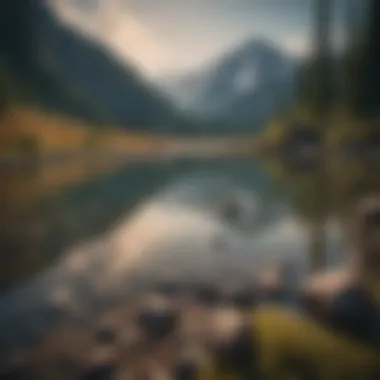

Such monitoring is beneficial as it helps both policymakers and anglers make informed decisions. For example, if a certain species is found to be declining, immediate actions can be taken to mitigate potential hazards, like restricting fishing in critical habitats. However, the downside comes when resources for maintaining monitoring processes are limited, leading to inaccuracies and gaps in data that could affect management decisions.
Research Initiatives
Research initiatives play a crucial role in understanding aquatic environments and informing conservation efforts. They bridge the gap between scientific knowledge and practical applications in fishing. The hallmark of these initiatives is their focus on evidence-based strategies, which ensure that fishing practices are guided by solid research rather than anecdotal tales.
Benefits of research initiatives include advancing knowledge about fish behavior, habitat preferences, and the effects of climate change on fish populations. This kind of research can lead to better management practices that promote fish health and sustainable fishing. Nevertheless, it’s worth noting that studies often require significant funding and time, which can limit the number of initiatives that could potentially be undertaken.
Best Practices for Anglers
Catch and Release Techniques
Catch and release techniques allow anglers to enjoy fishing while minimizing their impact on fish populations. The key characteristic of this practice is that it encourages the safe return of fish back to their habitat after being caught. This approach is beneficial as it not only helps maintain the population of fish but also provides unique experiences to anglers who prefer the sport over keeping the catch.
A unique aspect of catch and release lies in using specialized gear—like barbless hooks and well-padded nets—that further reduces the harm to fish. While its core strength is in preserving fish populations, some argue about the stress fish endure even when released. Therefore, understanding proper techniques becomes paramount to making this practice effective.
Minimizing Environmental Impact
Minimizing environmental impact means that anglers take steps to reduce their footprint on the ecosystem while fishing. The essence of this principle highlights the respect for nature and maintaining a balance. Key steps could involve proper waste disposal, avoiding sensitive areas, or even using eco-friendly gear.
This practice not only ensures sustainable enjoyment of fishing but also fosters a connection between anglers and nature. A potential downside could be the lack of awareness among some anglers about the severity of their actions. This can lead to harmful practices that detract from the overall intent of minimizing impact, thereby emphasizing the need for education and awareness.
Community Efforts
Community efforts involve local organizations and anglers working together to promote sustainable practices and conservation. These collective initiatives enrich the community, create connections, and propagate awareness about proper fishing and the importance of preserving waterways. The key characteristic of these efforts is their grassroots nature, which amplifies the voice of local fishermen and stakeholders.
Such community-based efforts offer advantages like organizing clean-up events, educational workshops, and advocating for better regulations that protect fish habitats. Yet, a unique challenge is the variability in commitment levels among community members, where the enthusiasm of some may not be matched by others, possibly affecting the overall effectiveness.
Through understanding these aspects of conservation, both seasoned anglers and newcomers can enhance their fishing experience, improve environmental stewardship, and actively contribute to the preservation of Washington State's rich fishing heritage.
Future Trends in Fishing in Washington State
Fishing in Washington State is evolving rapidly, amid a backdrop of technological advancements and changing policies. Staying abreast of these trends not only enhances the fishing experience but also ensures sustainability and responsible practices among local anglers. Embracing these shifts is paramount for both the health of the aquatic ecosystems and the enjoyment of fishing for generations to come.
Technological Innovations
Electronic Monitoring
Electronic monitoring is gaining traction within Washington's fishing practices. This involves using cameras and data collection devices to track fishing activities, both commercial and recreational. One key characteristic of electronic monitoring is its ability to provide real-time data on fish populations and fishing practices, fostering better decision-making.
The appeal of this system lies in its transparent approach to conservation. It encourages accountability among anglers and helps in controlling illegal fishing practices. The unique feature is that it allows for greater precision in assessing fish stocks, as it captures data that traditional methods may miss. However, there are concerns regarding privacy and the financial burden of implementing such technology, especially for smaller operations.
Data-Driven Fishing Practices
In the realm of fishing, data-driven practices are changing how anglers plan their trips. This translates into utilizing online platforms and mobile apps that compile historical data on fish catches, water temperature, and seasonal patterns. The pivotal aspect is its reliance on big data to guide fishing strategies, ensuring more fruitful experiences on the water.
This approach is popular among both seasoned and novice anglers, allowing for a tailored fishing experience based on factual insights rather than mere guesswork. Unique features include predictive analytics; by evaluating past trends, anglers can optimize their fishing times and locations. The downside might be the potential over-reliance on technology and the risk of neglecting traditional skills and knowledge.
Smart Gear Developments
Innovation in gear is another exciting advancement impacting fishing in Washington State. Smart gear integrates technology into traditional fishing tackle, such as rods and reels. A key characteristic of smart gear is that it often includes sensors that provide feedback on casting techniques or alert anglers when fish are biting.
The adaptability of smart gear makes it a beneficial choice for both casual and competitive fishing, as anglers can refine their methods based on real-time input. A standout feature includes connectivity to smartphones for tracking performance and patterns over time. Yet, the high costs associated with these advancements may put them out of reach for everyday fishers, limiting widespread adoption.
Policy Developments and Challenges
New Regulations
Regulatory frameworks are seeing changes that directly impact fishing practices. Recent new regulations aim to safeguard fish populations while ensuring fair fishing opportunities for everyone. A significant aspect of these regulations is their focus on sustainable practices, enhancing the long-term viability of fishing resources in the state.
These regulations also promote responsible behavior among anglers, fostering a culture of conservation. Unique to this trend is the increased collaboration between fisheries management and local communities, which helps to address specific regional challenges. However, the challenge remains in balancing regulatory enforcement with the needs of local fishers, where too strict regulations could lead to discontent.
Stakeholder Engagement
A critical piece of the future landscape involves stakeholder engagement. This entails actively involving various parties, including fishers, conservationists, and local businesses in the decision-making processes regarding fishing policies. The key characteristic of this collaboration is that it integrates diverse perspectives, leading to more comprehensive and effective regulations.
This engagement is crucial for gaining trust and ensuring that policies address the real concerns of those who fish and depend on aquatic resources. A unique feature is the use of community forums and workshops that facilitate open discussions. A downside is that these processes can be time-consuming and may not always yield immediate results for urgent issues.
Future Environmental Concerns
As we look ahead, environmental considerations loom large in discussions around fishing in Washington State. Climate change, pollution, and habitat degradation present challenges that could severely impact fish populations and fishing experiences. The essential characteristic here is that proactive measures are necessary to mitigate these risks, ensuring that fishing remains viable.
Focusing on environmental sustainability is not just beneficial; it’s vital for preserving ecosystems. Unique features of concern include shifting fish migration patterns and changes in breeding cycles due to altered water temperatures. While addressing environmental issues may involve costs and extensive planning, the long-term benefits outweigh these challenges.
"Adapting to pioneering technologies and establishing proactive policies is essential for the future of fishing in Washington State."
